The world of multi vendor ecommerce development is growing fast, but why are so many businesses still using single-vendor platforms that hold them back? With customer needs constantly changing, relying on just one seller limits growth.
The exciting part is that multi vendor ecommerce app are stepping up. They offer a way for businesses to grow faster. These platforms help meet the rising demands of today’s online shoppers.
Think about this: The future of ecommerce is clear: multi vendor marketplace development are poised for explosive growth.
Here are some reports by store hippo statistics data that highlight the potential of this model
- The global multi vendor marketplace market size is expected to reach $40.1 billion by 2025.
- 71% of online shoppers prefer marketplaces over standalone ecommerce websites.
- 62% of online sellers prefer selling on marketplaces over having their own ecommerce website.
- The average conversion rate of multi vendor marketplaces is 4-6%, thats a lot compared to single vendor.
The solution is clear, to succeed in this fast-moving market, multi-vendor ecommerce is the way to go. Whether you’re looking for multi vendor marketplace app development services or exploring the potential of a multi vendor ecommerce app development team, it’s time to move forward.
Leave the limits of the single-vendor model behind and take the next step toward a multi-vendor ecommerce marketplace development the way to go to a successful marketplace solution!
Let’s look at what Multi Vendor Ecommerce Development is:
Multi vendor ecommerce development creates an online marketplace for many sellers can manage their stores and sell products. it offers Customers get more choices, while businesses grow by attracting vendors.
“Sell products that your customers like in your multi vendor marketplace, and they’ll make purchases without a second thought.”
Let’s take a closer look at the details. We’ll show you how to build a multi vendor ecommerce marketplace or app to accelerate your business growth.
Key Takeaways
- Maximize revenue with minimal effort through multi vendor ecommerce development and a multi vendor ecommerce app, earning commissions without holding inventory. Increase revenue potential with minimal effort.
- Reduce operational costs with effective multi vendor ecommerce development strategies, automating vendor management and order fulfillment. Minimize operational costs.
- Increase customer satisfaction with a well-designed multi vendor ecommerce development platform and multi vendor ecommerce app providing product reviews and ratings. Enhance customer experience.
- Scale your business faster with a strong multi vendor ecommerce development solution, quickly adding new vendors and products. Enable rapid business growth.
- Gain a competitive edge with data-driven insights from Your multi vendor ecommerce development platform and multi vendor ecommerce app make informed decisions with valuable insights into customer behavior, sales trends, and vendor performance.
How to Build a Multi Vendor Ecommerce Marketplace App
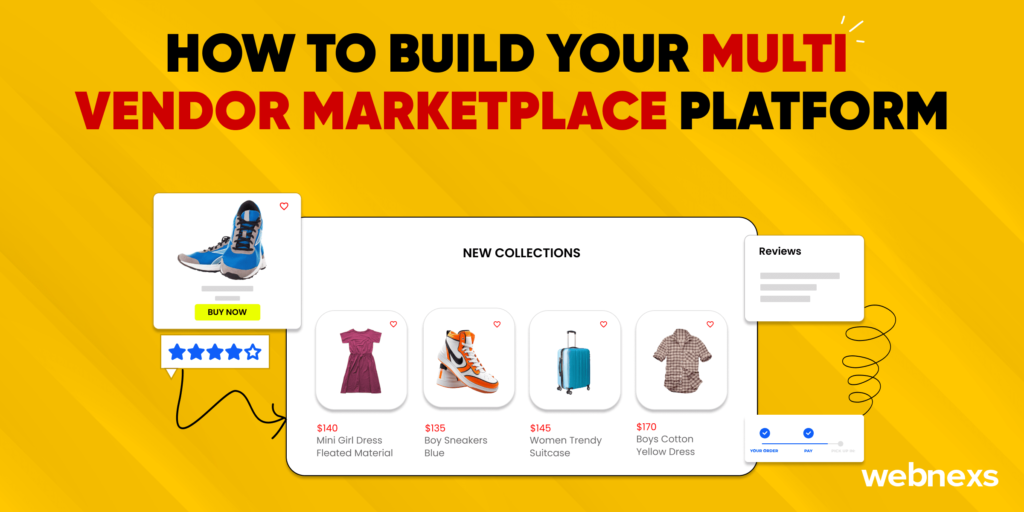
Creating a multi vendor ecommerce marketplace app can open up a world of possibilities for connecting vendors and customers. It might sound complex at first, but don’t worry! With the right strategies and tools, you can transform your vision into a successful marketplace that benefits all participants. By focusing on careful planning, effective execution, and continuous improvement, Here’s a step-by-step guide to help you navigate this process effectively:
1. Evaluate Ideas and Plan with a MultiVendor Marketplace App Builder
As you begin your ecommerce marketplace development, reviewing your ideas and creating a solid plan is important. Consider your target audience and how your multi seller marketplace development company will stand out from competitors.
Focus on features that will attract vendors and customers, how they will interact, and what technology you’ll use to grow.
Working with an experienced multi vendor marketplace app builder can help provide the tools and guidance you need for effective planning for your marketplace app.
i. Guide on Selecting the Right App Builder for Your Marketplace
When selecting the right app builder for your marketplace, consider the following key factors:
- Customization
Choose an multi vendor marketplace app builder that allows for customization to match your branding and specific business needs.
- Scalability
Ensure the app builder can accommodate growth as your ecommerce app expands.
- User Experience
Prioritize a builder that offers a smooth and intuitive user experience for both vendors and customers.
- Feature Set
Select a builder with features that align with your business model and target audience.
- Ease of Use
Opt for a builder with a simple and user-friendly interface for easy navigation and management.
- Support and Maintenance
Choose a builder that provides reliable technical support and maintenance services.
ii. Assessing Your Business Needs and Goals Before Development
Before building your multi vendor ecommerce marketplace app, consider the following essential factors:
- Target Market
Understand your target audience and their needs in the context of multi vendor ecommerce development.
- Revenue Model
Decide how you’ll earn money through commissions, subscriptions, or other methods for your ecommerce app.
- Essential Features
Ensure you include features like vendor registration, payment systems, and order management.
- Unique Selling Proposition (USP)
Define what sets your marketplace apart from competitors.
iii. Focus on the Product at Hand
When building your ecommerce marketplace app, keep the following product-focused factors in mind:
- Product Offerings
Ensure your products stand out through competitive pricing, niche selections, or excellent customer service.
- Advanced Product Listing
Choose an app builder that supports advanced product listing features, search capabilities, and high-quality visuals for your marketplace app.
- Product Customization
Allow vendors to customize their product listings to match their brand and offerings.
iv. Start Small and Scalable
When launching your marketplace, consider the following key factors for starting small and scaling:
- Initial Vendor Onboarding
Focus on onboarding a select group of quality vendors first.
- Core Features
Start with core features and gradually expand as your marketplace app grows.
- Scalable Architecture
Ensure your marketplace is built with a scalable architecture to accommodate growth.
v. Learn Fast and Adapt Quickly
After launching your multi vendor ecommerce app, prioritize the following factors for continuous learning and adaptation:
- User Feedback
Gather feedback from vendors and customers to identify areas for improvement in your marketplace app.
- Performance Metrics
Monitor key performance metrics such as sales, customer acquisition, and vendor satisfaction.
- Adaptation
Be prepared to make changes and adjustments based on user feedback and performance metrics.
vi. Fail Fast and Iterate
When building your multi vendor marketplace app, remember that failure is an essential part of the process. Consider the following factors for embracing a “fail fast” approach:
- Experimentation
Encourage experimentation and testing of new features and ideas for your ecommerce app.
- Risk Management
Identify potential risks and develop strategies for mitigating them.
- Iteration
Be prepared to iterate and make changes based on the results of experimentation and testing.
vii. Add Vendors Strategically
When adding vendors to your marketplace, consider the following key factors:
- Vendor Selection
Choose vendors that align with your marketplace’s focus and values.
- Onboarding Process
Make the onboarding process easy and provide support to help vendors set up quickly.
- Vendor Management
Develop strategies for managing vendors, including performance monitoring and feedback mechanisms.
Interesting Fact!
80% of customers choose marketplaces based on competitive pricing, so consider offering discounts, promotions, or loyalty programs.
Key to Success
Building a successful multi vendor marketplace app requires careful planning, effective execution, and continuous improvement. By following these steps and staying focused on your goals, you can create a successful marketplace that benefits both vendors and customers.
Develop Your Multi Vendor Ecommerce Website Now!
2. Development Process of a Multi Vendor Ecommerce App
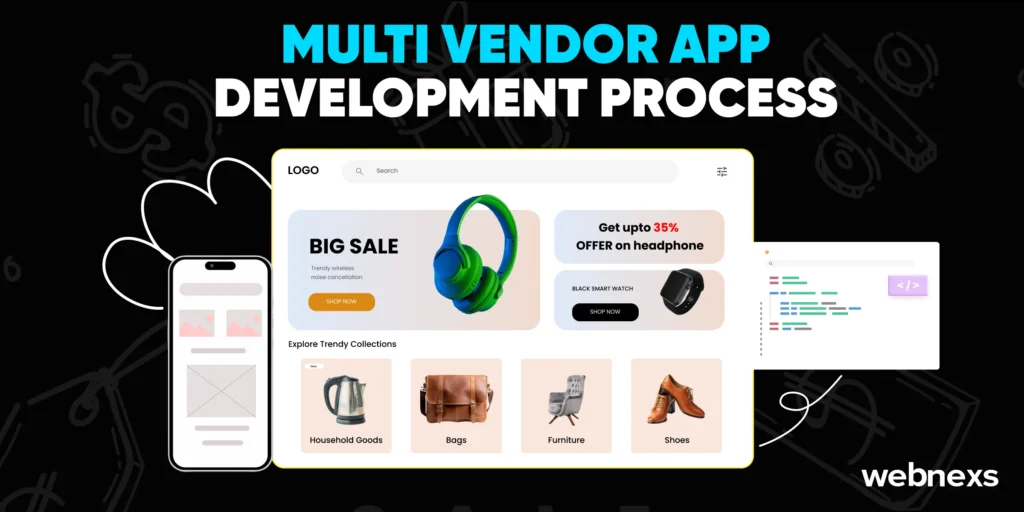
Building a successful ecommerce marketplace app involves several important steps to ensure a good user experience and strong functionality.
Here’s how the development process works,
i. Prototyping
The first step is to create a working prototype for testing. This helps you see how the app will work and identify any issues before full development. Getting feedback from users and stakeholders at this stage makes it easier to improve the app.
ii. Creating a Design on Web and App Screens
Next, design user-friendly interfaces for both vendors and customers. The design should be easy to use, allowing users to navigate the app without confusion. Focus on creating attractive layouts that showcase products well, including features like search filters and simple checkout processes.
iii. Programming
- Technology Selection
Choose the right technology for your multi vendor ecommerce app. This means picking the programming languages, frameworks, and tools that will support your app’s features and help it grow.
- Database Orchestration
Set up a well-organized database to manage the large amounts of data from multiple vendors. Make sure the database runs efficiently and handles transactions smoothly.
- Server Handling to Have Traffic
Prepare your server to manage incoming traffic, especially during busy times. Choose reliable hosting solutions and use load balancing to keep the app responsive and accessible.
- Develop the App’s Core Features
Focusing on scalability and user experience. Important features should include vendor registration, product listings, order management, and payment processing.
Ensure a smooth and secure experience for users, which is key to the success of your multi vendor ecommerce marketplace.
Key Objectives to Know Before Building a Multi-Vendor E-commerce App Development
When building a multi-vendor e-commerce app development, your main goals are:
- Attracting vendors to your marketplace app by offering them a streamlined, profitable selling experience.
- Facilitating smooth transactions for both vendors and customers through a reliable and easy-to-navigate platform.
- Building trust and loyalty by ensuring product quality, transparent processes, and great customer support.
Read More: Key Things To Consider Building Multi Vendor Marketplace Development
Selecting the Right Business Model for Your Multi Vendor Ecommerce Development

The business model you select will impact how you generate revenue and engage with your vendors. Here are three popular models to consider:
1. Commission Model
In the commission model, platform owners charge vendors a commission on each sale they make through the marketplace. This means that a percentage of the sale price goes to the marketplace owner for every product sold. This model encourages platform owners to actively promote products, as their earnings are directly tied to sales. It also allows vendors to start selling without upfront costs, making it an attractive option for both parties.
Example: Amazon Associates, which allows website owners to earn commissions by promoting Amazon products.
Did You Know? In 2020, Amazon paid out over $10 billion in commissions to its associates.
2. Membership Model
Under the membership model, vendors pay a fixed membership fee to list their products on the marketplace. This fee can be charged monthly or annually, providing a steady stream of income for the platform owner. In return, vendors gain access to the marketplace, tools, and resources to help them succeed. This model can appeal to vendors who plan to sell consistently, as it offers a predictable cost structure while allowing them to reach a broader audience.
Example: Walmart+ offers benefits like free shipping and discounts on fuel to its members.
Did You Know? Walmart+ had over 20 million subscribers in the U.S. as of 2022, generating an estimated $1.5 billion in annual revenue.
3. Listing Fees
With the listing fees model, vendors are charged a fee for each product they list on the marketplace. This approach helps cover the platform’s costs and ensures that only serious vendors participate. Listing fees can be structured as one-time charges or recurring fees, depending on the platform’s strategy.
Example: eBay charges sellers to list their products for sale.
Did You Know? In 2020, eBay generated approximately $10.7 billion in revenue from listing fees and related services.
Read More: Build your online multi vendor marketplace sites like Alibaba Now!
Amazon’s Success as a Multi Vendor Marketplace
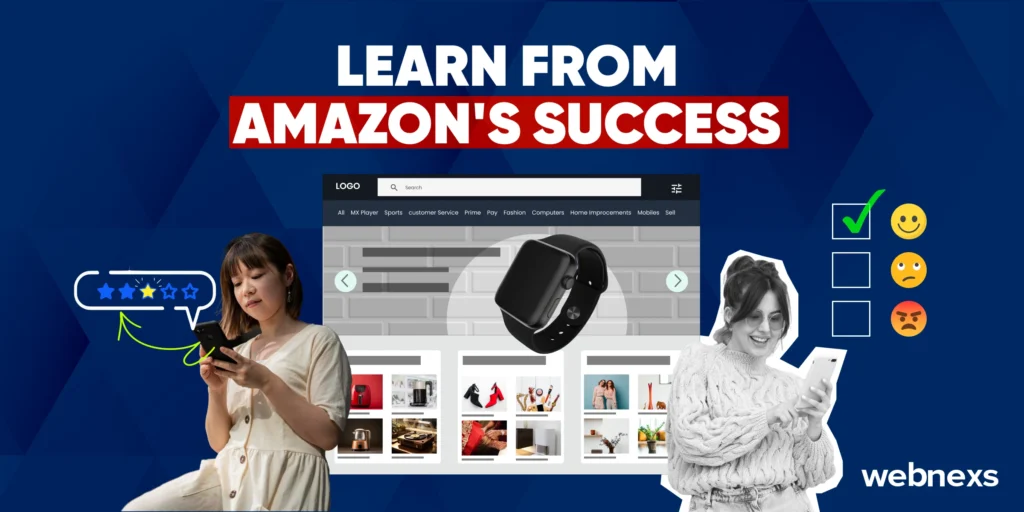
How Amazon’s Marketplace Works
Amazon is a perfect example of a successful multi vendor marketplace. It started as a humble online bookstore, launched by Jeff Bezos in 1994, and quickly expanded to become an “everything store.” By allowing third-party sellers to list their products, Amazon diversified its inventory, making it a one-stop shop for customers.
This move built trust between vendors and consumers, with Amazon providing a reliable platform for transactions. Businesses can learn from Amazon’s focus on customer experience, vendor relationships, and logistics to succeed in the marketplace space.
Lessons from Amazon’s Business Model
Amazon has become one of the most successful and well-known companies in the world, thanks to its powerful business models. Its success lies in several key strategies that make it stand out in the ecommerce world. Here are some of the most impactful models that have helped Amazon maintain its popularity and growth:
- User-Friendly Experience
- Seamless Vendor Onboarding
- Focus on Customer Satisfaction
Let’s take a closer look at these models and how they can help you build a successful multi vendor marketplace development.
1. Creating a User-Friendly Experience
One of Amazon’s core strengths is its focus on creating a simple and intuitive shopping experience for customers. Whether it’s making shopping easier for buyers or simplifying the process for sellers, Amazon makes it all about ease and convenience.
Why It Works
- Personalized Shopping
Amazon uses customer data to personalize recommendations, making the shopping experience feel unique to each user. This personalization helps keep customers engaged and more likely to make a purchase.
Interesting Stat – 80% of Amazon customers are more likely to buy a product when the shopping experience is personalized.
- 1-Click Ordering
Amazon’s 1-Click ordering system allows customers to complete their purchases with just one click, minimizing the effort involved in checkout and increasing sales.
Interesting Stat – This simple feature boosts conversions by 10-15%, as it reduces the friction that often prevents customers from completing their purchases.
Impact on Your Marketplace
For your multi vendor ecommerce development, focus on creating a smoothless and personalized experience for customers. This could mean customizing product recommendations, simplifying the checkout process, and using tools that make shopping easier. If you make the shopping process smooth and convenient, customers will return to your platform again and again.
2. Seamless Vendor Onboarding
Amazon has perfected the process of bringing new sellers onto their platform, and this has contributed significantly to its success. A smooth, easy onboarding experience encourages more vendors to join, which increases the variety of products and services offered to customers.
Why It Works
- Quick Setup
Amazon’s vendor onboarding process is incredibly fast, taking only 24-48 hours. This speed allows new vendors to start selling their products almost immediately, without unnecessary delays.
Interesting Stat – 75% of Amazon vendors say the onboarding process was easier than they expected, which helps to build trust and satisfaction.
Impact on Your Marketplace
Make it easy for new vendors to join your marketplace. Provide them with clear, simple instructions, quick approval processes, and easy-to-use tools for managing their listings. The quicker you can get vendors up and running, the more likely they are to stay and grow on your platform.
3. Focusing on Customer Satisfaction
Customer satisfaction is at the heart of Amazon’s success. The company goes above and beyond to ensure customers are happy, offering fast shipping, easy returns, and high-quality customer service. These policies contribute to high customer retention and trust.
Why It Works
- Free Shipping
Amazon offers free shipping on many products, which is a big draw for customers. By removing shipping costs, Amazon encourages more people to make a purchase.
Interesting Stat – 90% of Amazon customers say free shipping is a key factor in their purchasing decisions.
- Easy Returns
Amazon’s return process is simple and customer-friendly, with easy steps for returning unwanted products. This builds trust and confidence in their service.
Interesting Stat – 95% of customers are satisfied with Amazon’s return process, which boosts customer loyalty and keeps buyers coming back.
Impact on Your Marketplace
Focus on customer satisfaction by offering reliable, fast shipping, an easy return policy, and excellent customer support. Make it as easy as possible for customers to shop and resolve any issues, and they will appreciate the convenience and keep returning to your platform.
By applying these strategies to your marketplace, you can build a platform that stands out from the competition, attracts new vendors, and keeps customers coming back for more. Start implementing these lessons, and you may find your marketplace growing just like Amazon’s!
Build your Amazon like multi vendor marketplace website
Overcoming Challenges in Multi Vendor Marketplace development

Developing and managing a successful multi vendor marketplace comes with its set of challenges. From managing vendor relationships to ensuring technical stability and building customer trust, these hurdles must be addressed carefully to ensure long-term success. Below, we highlight the key challenges and strategies to overcome them effectively.
1. Vendor Management
Managing vendors in a multi vendor marketplace is a critical yet challenging task. Convincing vendors to trust a new marketplace, onboarding them effectively, and ensuring their performance aligns with your platform’s goals are all complex, but necessary, processes.
Why It’s Important
Strong vendor management can improve relationships and lead to a 20% increase in cost savings, which benefits both the vendors and the platform.
Key Challenges
- Vendor Verification and Approval
Ensuring the credibility of vendors is vital for building trust. A rigorous vetting process helps guarantee that only reliable sellers are approved.
- Vendor Education and Training
Vendors need proper guidance on using your platform. Without adequate training on policies, procedures, and tools, they may struggle to succeed, leading to inefficiencies.
- Quality Control
With multiple vendors, maintaining consistent product quality is a challenge. Inconsistencies can damage the brand’s reputation and affect customer satisfaction.
- Vendor Performance Monitoring
Continuously tracking vendor performance is necessary to ensure they meet expectations and help improve their efforts.
- Payment and Financial Discrepancies
Clear payment terms and a smooth payment process are essential. Mismanagement or delays in payments can strain vendor relationships.
Overcoming Vendor Management Challenges:
- Use tools like SAP Ariba or Coupa for tracking vendor performance and managing contracts.
- Automate communications and monitor vendor activities to improve efficiency.
- Regularly review vendors and use data to assess their impact on your marketplace.
2. Technical Complexity
The technical infrastructure of your multi vendor marketplace must support smooth operations, secure transactions, and efficient data management. Investing in reliable, user-friendly technology is crucial for keeping both vendors and customers satisfied.
Why It’s Important
Technical issues can decrease customer satisfaction by 20-25% and increase churn by 12-15%.
Key Challenges
- Ensuring seamless transaction processing, effective inventory management, and robust data security while avoiding technical glitches that could hinder the customer experience.
How to Overcome Technical Challenges:
- Implement user-friendly technology and prioritize secure payment systems.
- Regularly update your platform and perform maintenance to prevent technical issues.
- Partner with skilled developers to build a strong infrastructure and improve overall platform performance.
3. Building Customer Trust
In a competitive marketplace, building and maintaining customer trust is essential. Customers need to feel confident in your platform, knowing that their data is secure, products are reliable, and return policies are fair.
Why It’s Important:
Lack of trust can reduce sales by 15-20% and lead to a 25-30% drop in customer loyalty.
Key Strategies to Build Trust:
- Transparency
Clearly communicate product details, pricing, and return policies to set customer expectations.
- Secure Transactions
Implement secure payment systems to protect customer data and enhance trust.
- Customer Feedback
Encourage positive customer reviews to build credibility and show you care about their satisfaction.
How to Achieve Customer Trust:
- Offer transparent communication about products, prices, and policies.
- Use secure payment systems and ensure customers feel safe during transactions.
- Encourage customers to leave reviews and respond quickly to any inquiries.
4. Competition and Market Saturation
The multi vendor marketplace envirnment is highly competitive, and standing out is essential for success. Understanding your audience and differentiating your platform through unique selling propositions (USPs) can help you attract more customers.
Why It’s Important
Without differentiation, your marketplace can lose market share by 10-15% and decrease brand recognition by 12-18%.
How to Overcome Competition:
- Unique Selling Propositions
Identify what makes your platform stand out and communicate that clearly to your audience.
- Exclusive Products and Services
Offer products or services that can’t be found on other platforms.
- Branding and Marketing
Invest in effective branding and use social media to create strong visuals that appeal to your target audience.
How to Achieve Differentiation:
- Highlight your marketplace’s unique features and value propositions in marketing campaigns.
- Offer personalized customer service and exclusive products to build loyalty.
- Customize your marketplace features using app builders to meet your customers’ needs.
5. Regulatory Compliance
Navigating the legal and regulatory landscape is crucial for any ecommerce business. Compliance with data protection, consumer rights, and tax laws is vital for ensuring credibility and protecting your business from penalties.
Why It’s Important
Non-compliance can increase the risk of fines and penalties by 80-90% and damage your business reputation 100%.
How to Overcome Regulatory Challenges:
- Stay Informed
Keep up with changes in ecommerce regulations to avoid compliance issues.
- Automate Compliance
Use tools to manage legal and regulatory requirements, ensuring data protection and proper tax filings.
- Train Vendors
Provide training for vendors to ensure they are aware of the regulations and adhere to them.
How to Achieve Compliance:
- Regularly update your knowledge of changing regulations and ensure all vendors comply.
- Use automated tools to ensure compliance with data protection laws and tax regulations.
- Provide training and resources to vendors to minimize compliance mistakes.
Top 5 Benefits of Developing a Feature Rich Multi Vendor Ecommerce App
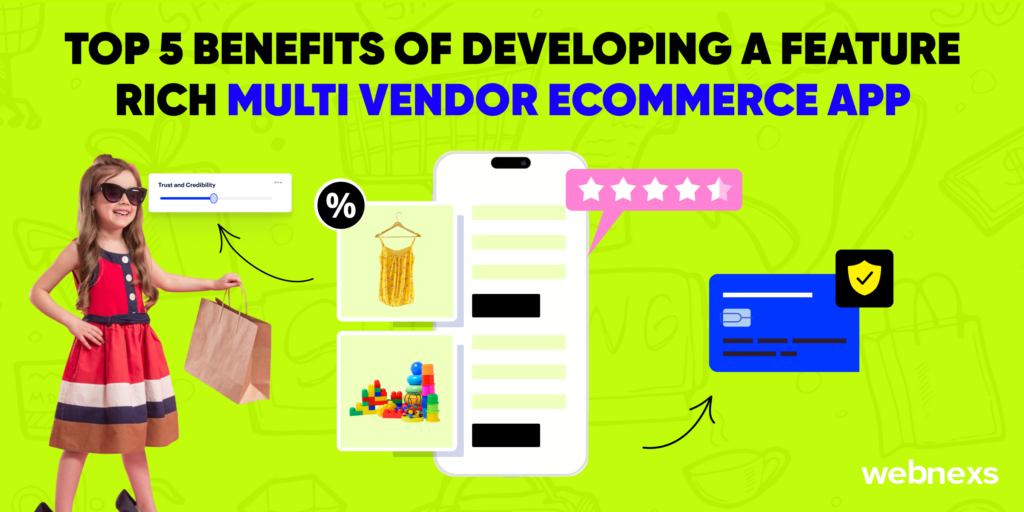
Before starting a multi vendor marketplace, it’s important to first get a handle on ecommerce as a single vendor. This means dealing with things like managing customers, keeping track of inventory, running your website, handling shipping, and making sure products are packaged well.
Gaining experience in these areas will help you improve your processes, deliver a better customer experience, and solve logistical issues. Once you’ve mastered these skills, you’ll be in a much stronger position to manage the complexities of a multi vendor marketplace development.
1. Increased Trust and Credibility
- Featuring a wide range of verified vendors boosts the marketplace’s credibility.
- Customers feel more confident when they see that sellers are trustworthy and vetted.
- Establishing trust helps attract repeat customers and encourages word-of-mouth referrals.
2. User-Friendly Experience
- Customers can find various products all in one place, making their shopping experience more convenient.
- Vendors benefit from an easy outlet to reach local and global customers, especially in regional marketplaces.
- The platform simplifies the process of comparing products, checking availability, and choosing the best deal.
3. Flexible Payment Options for Vendors
- A successful multi vendor ecommerce marketplace integrates multiple secure payment gateways, making transactions smooth for both vendors and customers.
- Vendors can expand their online presence by offering customers various payment options, further enhancing the customer experience.
4. Enhanced Customer Loyalty
- Loyalty programs and personalized offers within a multi vendor app keep customers engaged and encourage repeat purchases.
- A seamless shopping experience, paired with exclusive deals, ensures long-term customer retention, which is key to growing a multi vendor ecommerce marketplace.
5. Real-Time Analytics
- Multivendor marketplace app development services provide real-time data insights, allowing vendors and platform owners to monitor performance.
- Analytics can help businesses understand customer behavior, optimize marketing strategies, and make data-driven decisions to improve overall success.
Top 5 Features for a Successful Multi Vendor Marketplace App Development Services
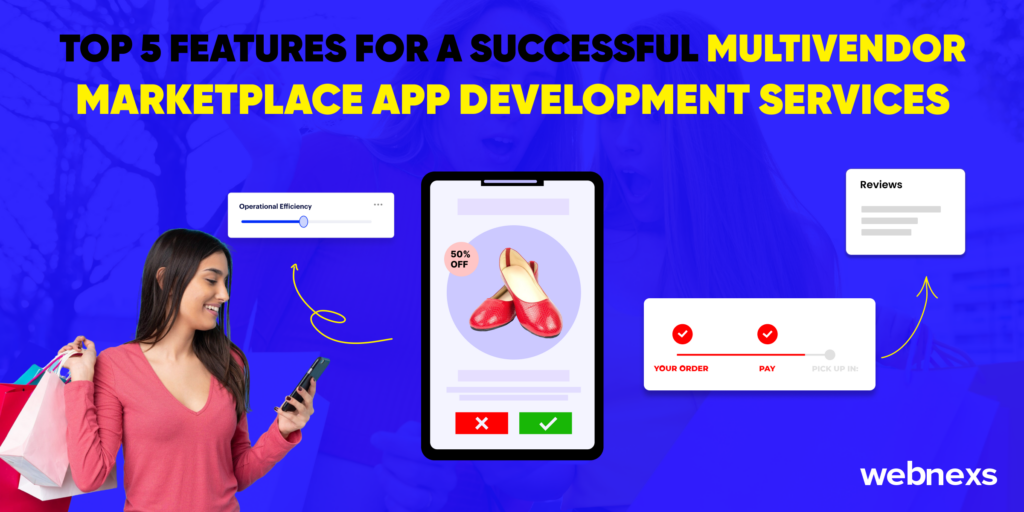
When developing a multi vendor ecommerce app, the right features is essential to ensure a seamless user experience and efficient operations. Below are the top five features to consider, along with their advantages and benefits:
1. Product Comparison
Allow customers to compare products from different vendors. This feature helps shoppers make informed decisions by showing them the differences in price, quality, and features.
Advantages
Allows customers to compare products from different vendors, shows differences in price, quality, and features, and provides an easy way to compare options.
Benefits – Improves customer satisfaction, encourages more purchases, and helps customers make informed decisions.
2. Customer Reviews Across Sellers for a Single Product
Build trust by allowing customers to leave reviews and ratings for a single product, regardless of which vendor they purchased it from.
Advantages
Allows customers to leave reviews and ratings for a single product, provides verified customer reviews, and gives potential buyers confidence in product quality.
Benefits – Builds trust, encourages vendors to maintain high standards, and helps create a loyal customer base.
3. Discounts
Offering discounts and promotions can attract customers to your marketplace.
Advantages
Attracts customers to the marketplace, provides special deals or limited-time offers, and encourages purchases.
Benefits – Increases sales, creates excitement around the marketplace, and makes the marketplace more appealing to shoppers.
4. Enhanced Operational Efficiency
Optimizes your operations from vendor onboarding to product listing, packing, and shipping.
Advantages
Improves operations from vendor onboarding to product listing, packing, and shipping, and makes it easier for vendors to join and manage their products.
Benefits – Ensures smooth operations, allows the marketplace to grow without hiccups, and reduces operational costs.
5. Payment Gateway
Implement secure and flexible payment solutions for both vendors and customers.
Advantages
Provides secure and flexible payment solutions, ensures safe and easy transactions, and allows customers to pay with various methods.
Benefits – Increases customer convenience, reduces payment disputes, and helps vendors receive payments quickly.
Conclusion
Building a new multi-vendor ecommerce app is easier than you think especially when you partner with the expert multi-vendor marketplace developers at Webnexs! The key is to focus on the right idea for your business.
“After studying many successful marketplace stories, now is your chance to chase the dream you’ve always wanted. Don’t miss this opportunity!”
The experts at Webnexs are ready to help you! We provide valuable insights and personalized guidance to meet your unique needs for your multi vendor ecommerce development. Reach out to us to assist you in creating a successful marketplace! Feel free to contact us!





